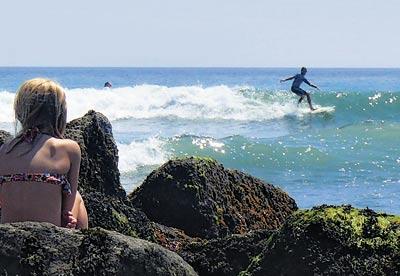They Tried to Ban Surfing

The annual Rell Sunn surf contest was held at Ditch Plain Beach in Montauk on Saturday. Each year the tournament’s entry fees, raffles, and auction raise money to help disadvantaged members of the community.
The event’s namesake was a generous and beloved teacher from the west side of the island of Oahu, Hawaii. She was also a graceful surfer who inspired young women to paddle out for their fair share of waves in what had been — even in recent times — a male-dominated domain. Before missionaries frowned the aloha out of surfing, the semireligious sport was enjoyed by men and women alike. Rell Sunn was taken by breast cancer in 1998.
Rell Sunn spread the spirit of aloha throughout the world. Montauk’s annual benefit in her name has become a joyous, aloha-filled day that brings our already close-knit surfing community closer still. I should say, surfing family.
In fits and starts, the family has grown from the time, in 1949, when Richard Lisiewski, a soldier from New Jersey drove to the Army’s Camp Hero in Montauk with his homemade, 100-pound surfboard stuffed in the back of his Cadillac convertible. As far as we know, he was the first person to ride waves with a surfboard in Montauk, although another soldier named Teddy Roosevelt enjoyed a tumble in the waves, according to a newspaper account at the time. The year was 1896 when all of Montauk became Camp Wikoff, where soldiers recuperated from service in the Cuban campaign of the Spanish-American War.
By the late 1960s, the revolution spawned by the Beach Boys and lightweight surfboards made of polyurethane foam and fiberglass brought the first wave of surfers who put down roots here. A significant portion of Montauk’s current fishing community was drawn here by Montauk’s waves. At the time, there was a bit of shoreside exuberance, minor vandalism performed by a few unruly surfers, so in 1969, the East Hampton Town Board set out to ban surfing in the town.
That would have been impossible to enforce, of course, but to preclude an us-versus-them vibe, Perry B. (Chip) Duryea III joined forces with the Rev. Howard Friend of the Montauk Community Church to smooth the waters. The board relented with the caveat that all surfers must register with the town and wear a medallion. The medallion would identify them as legitimate, law-abiding members of the community as compared to those pot-smoking vandals “from away.” It worked for about two weeks.
One of the medallions and the story behind it will be on display at the new Montauk Surf Museum, otherwise known as the Montauk Oceans Institute, which will be in the small white brick building next to the Montauk Lighthouse overlooking three of the most popular surf breaks on the entire East Coast.
The surf museum will be an adjunct to the Montauk Lighthouse Museum, and while its installations will include the general and local history of surfing, they will also depict the science of surfing. Beyond its trendy social aspects and its physical poetry, the sport of surfing grows from a complex interplay of natural forces.
The museum hopes to explain the meteorology of waves and currents, the geology of ocean bottoms, the marine science of the creatures with whom we share the sea, as well as the destructive energy of a superstorm like Sandy.
The museum is about a year away from opening. Its organizers, of whom I’m one, are just now beginning to reach out to the community for memorabilia and photographs of significant moments in local surfing history. “The Trailer Park,” for instance, now the Montauk Shores Condominiums, where grandfathers, grandmothers, mothers, and fathers of the menehunes (little people) who competed in Saturday’s Rell Sunn first put down their surfing roots in Montauk.
One more thing: The surf on Saturday could not have been better for a Rell Sunn event. A sweet north wind shaped up a modest south swell to create a perfect stage for young surfers to strut their stuff. I say young surfers, but the beauty of surfing is that everyone doing it is young, or becomes young once again.
The day after the Rell Sunn, Tom Curren, one of the best surfers in the world, paddled out at Ditch Plain on a 12-foot soft-top board to play in small choppy waves wearing a straw hat and short-sleeved oxford shirt — just another kid — proving once again that aloha is the opposite of pretense. Mahalo, Rell.
